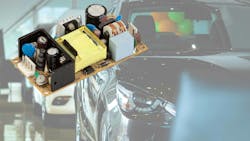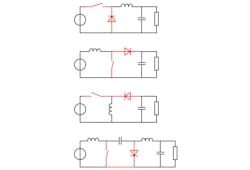Pinpointing the Best DC-DC Converter for Your EV Design
Members can download this article in PDF format.
What you’ll learn:
- Primary types of non-isolated converters.
- Primary types of isolated converters.
- Challenges selecting DC-DC converters.
At the heart of modern electric vehicles is the DC-DC converter. It delivers the right operating voltage to specific components and enables the high-voltage, main battery pack to feed power to the crucial lower-voltage systems that control vehicle operations and provide creature comforts to occupants.
Some DC-DC converters can be crafted to transfer from the input to the output, in only one direction. But the majority of DC-DCs can be made bidirectional, which is especially useful for implementing regenerative braking.
One of the ways the amount of power that flows from the input to the output can be controlled is by altering the converter’s duty cycle. This capability can be used to control output voltage, input current, or output current to deliver constant power. Many kinds of converters are available on the market and many more could be created using different design principles. Issues to consider include noise, isolation, efficiency, and cost.
Common Types of Non-Isolated Converters
A whole set of variations are possible within the concept of the non-isolated converter. The four most common switching non-isolated types are buck, boost, buck-boost, and Ćuk (see figure):
- Buck: Also known as a step-down converter, this DC-DC converter decreases voltage while increasing current from its input to its output. Its big advantage is efficiency can exceed 90%—better than linear regulators that dissipate power as heat in the conversion process.
- Boost: A DC-DC converter, sometimes called a step-up converter, creates an output voltage higher than the input voltage, but, of course, the output current is lower than the source current. This kind of circuitry can tend to be heavy and fares poorly with voltage ripples.
- Buck-boost: This converter has an output voltage magnitude greater than or less than the input voltage magnitude. It’s comparable to a flyback converter with a single inductor instead of a transformer.
- Ćuk: This form of buck-boost converter has low ripple current. Ćuk converters combine features of a boost converter and buck converter, with a single switching device and a shared capacitor.
Two of the many other non-isolated designs include charge pump and magnetic converter:
- Charge pump: Charge pumps are simple and can be as efficient as 90% to 95%. They use capacitors for charge storage to raise or lower voltage. They can double voltages, triple voltages, halve voltages, invert voltages, multiply or scale voltages (e.g., x4/3), or create other voltages by simply alternating between modes using a controller.
- Magnetic converter: This type of DC-DC converter stores energy and then releases it as a magnetic field in inductors or transformers within a specified frequency range. Often used to maintain constant power across circuits.
Galvanically Isolated Converters
Isolated converters use a high-frequency transformer where output is completely separated from input. Sub-types include half-bridge, full-bridge, flyback forward, and push-pull. Each can be used for bidirectional conversion.
The isolation refers to galvanic isolation—there’s no direct conduction path between two parts of the circuit. This barrier can be helpful for safety and for some kinds of functionality, and it’s particularly important with higher voltages and currents. Some isolated converters have a single input and single output while others have multiple outputs.
Isolated converters can also be classified as: operational or functional where there’s an isolated output but not fault protection; basic, with only single-fault protection; and, reinforced with 2X insulation for greater fault protection.
Other key characteristics of DC-DC converters include:
- Current rating: The maximum value of current that can be provided to a load on a sustained basis.
- Temperature rating: Ambient conditions and heat created during operations can combine to create relatively high temperatures. The temperature rating involves what can be tolerated during operation under full load without causing damage or component failure.
- Ripple voltage: It can be important to consider the waveform artifact of an AC source, which can lead to a ripple voltage at the converter output. The resulting voltage fluctuations and potentially current fluctuations may impact the efficiency and longevity of circuits and components using that power.
What are the Major Challenges with DC-DC Conversion?
- RF noise: Switching converters have a bad habit of emitting RF at the switching frequency and its harmonics. How much of a problem it becomes depends on the converter’s proximity to RF-sensitive circuits as well as the strength of the RF and whether it’s sufficient to run afoul of regulations.
- Safety: Certain DC-DC converters can decrease input voltages by hundreds of volts. If, for some reason, the converter fails, the input voltage can become deadly for operators or patients (in the case of medical devices). Therefore, converters must have sufficient electrical insulation between the primary and secondary circuits.
Selecting or designing a DC-DC converter is important in any application. It’s particularly the case in an EV, where the right design can have a positive impact on vehicle performance, overall efficiency, safety, and reliability.
References
About the Author


